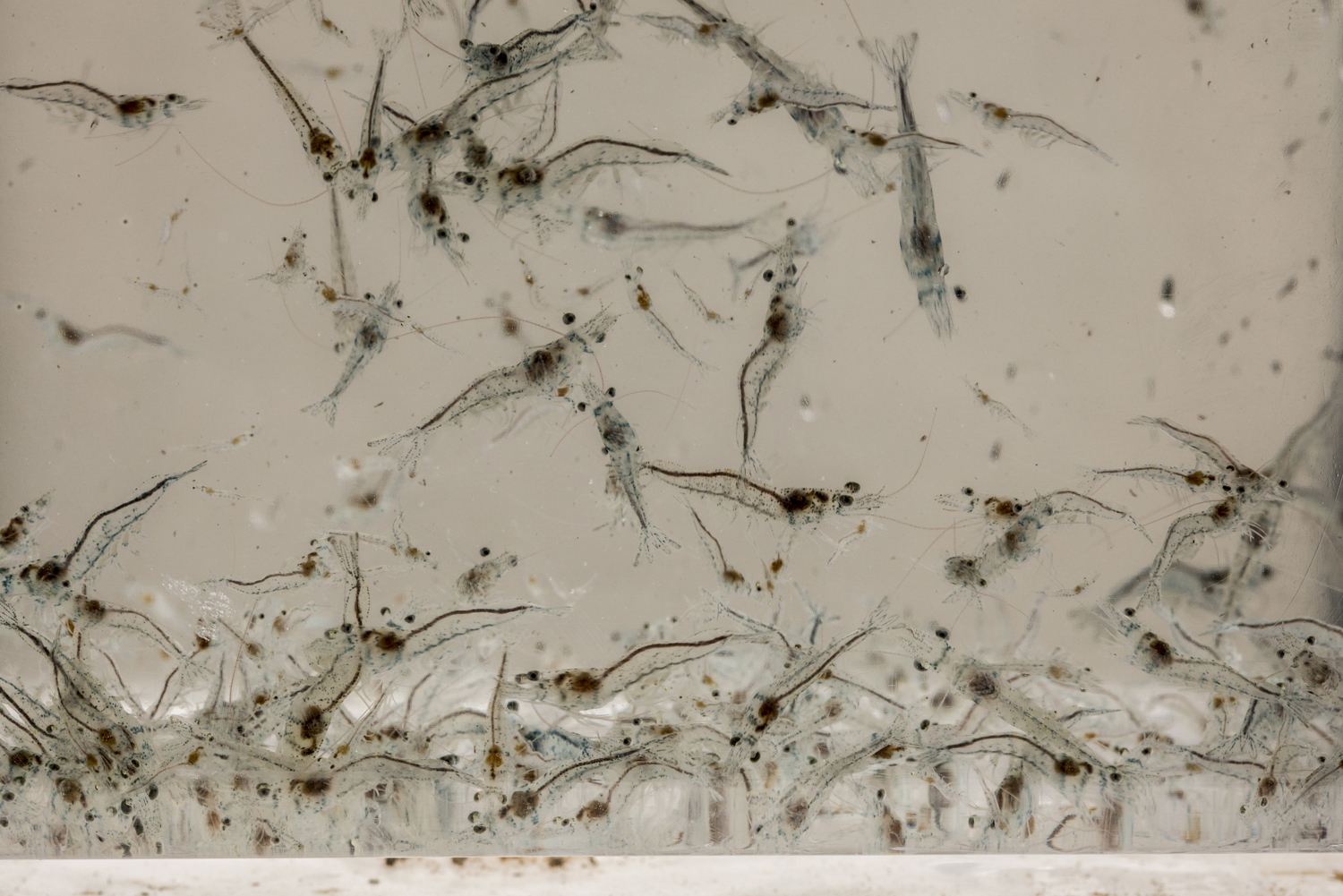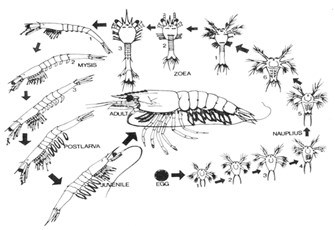Good practice in feeding and management of shrimp larvae is essential in ensuring optimum health, welfare, and growth of farmed shrimp. Fry and larvae quality is one of the main drivers for successful fish and shrimp farming. The feeding and nutrition of shrimp larvae is based on supplying feeds that are ingested by the larvae and meet the nutritional requirements of the different larval stages.
Role of optimal Formulated Feeds for efficient Shrimp Larval Development with reference to L.Vannamei

The Pacific white shrimp, Litopenaeus vannamei is originated from the Western Pacific coast of Latin America stretching from the south of Peru to the north of Mexico. This species was introduced commercially into China and Taiwan in 1996 and other coastal Asian countries started to culture this species in early 2000. Since then, L. vannamei became one of the important penaeid species farmed worldwide. Shrimp larvae quickly go through major changes in body structure requiring a series of different feeds and environmental conditions to meet their needs.
Fig :1 Larval stages of Shrimp (L. Vannamei)

Types of Larval feeds
Algae and Artemia
Live algae and Artemia nauplii pose high with respect to introduction and thereafter and spread of pathogens.
Formulated Feeds
Larval feeds should originate from trustworthy suppliers that certify absence of pathogens in the product and raw materials. Successful production of robust post larvae for stocking in grow-out ponds largely depends on feed quality and the feeding schedule that is applied in the hatchery. The metamorphosis of L. vannamei through larval stages into post larvae is a complex process (see Figure 1, life cycle), which in the wild is characterized by migration to inshore, brackish estuaries. This shift from pelagic to bottom-dwelling benthic behavior is accompanied by a change in feeding habit from an herbivorous to an omnivorous died Growth and development of the digestive system affects digestive capability, mainly due to qualitative and quantitative fluctuations in digestive enzyme production. Larval stages, therefore, differ in nutritional requirements. Feed formulation and feed processing are tailored to the specific needs of each stage (Table 1)
Feeding characteristics of Shrimp larvae
|
Zoea Stages |
Feed Character |
|
Z1, Z2, Z3 First feeding Stages |
Size range 5–30μm |
|
Pelagic filter-feeder |
High density of feed particles or Slow sinking |
|
High energy turnover, 10–20 minutes gut passage time |
Dry feeds are algal replacement diets |
|
High lipase activity |
Highly digestible feed |
|
Mysis Stages |
|
|
M1, M2,M3 |
High density of feed particles |
|
Size range: 30–90μm |
|
|
Pelagic filter-feeder |
Neutrally buoyant or slow-sinking particles |
|
10–20 minutes gut passage time |
Highly digestible feed |
|
High protease and medium lipase activity |
Moderate lipid level: 10–15% high protein 50-60% |
|
Early post larval stages |
|
|
PL1, PL2, PL3, PL4 |
Size range: 90–250μm |
|
Omni / carnivorous, active, hunting behavior |
Co-feeding of Artemia to live nauplii and formulated feed |
|
15–20 mins gut passage time |
Highly digestible feed |
|
Low enzyme activity |
Moderate lipid level 10-15% high protein 45-55% |
|
Post Larval stages |
|
|
PL5 to PL 15 |
Size range: 300–500/800μm |
|
Benthic feeder |
Sinking feed |
|
30 mins gut passage time |
Moderately digestible feed |
|
Increased digestive capacity |
Low lipid level: 5–10% Moderate protein 40-45% |
Different phases of shrimp larvae




Zoeya Mysis Early post Larvae Post Larvae
Features of hatchery feed nutrition
Formulated feeds have similar composition similar to micro algae and zooplankton with high levels of essential nutrients such as vitamins, minerals, pigments like astaxanthin, highly unsaturated fatty acids, cholesterol, and lecithin. Good quality feeds use highly digestible raw materials with good nutritional value. Shrimp larvae develop through a series of stages each requiring a different mix of feed type, size, and texture. Their feed intake depends on several factors such as temperature, water quality and growth potential of the strain amongst others. Formulated feed has been developed to meet the needs of shrimp larva and reduce the need for live feed. Variation in feed quality can also influence the amount of feed required.
Effective feeding Management for Hatchery Diets
Monitoring at each feeding
|
Monitoring |
Observation |
|
Swimming Activity |
Highly active to inactive |
|
Mortality |
Zero, low or high numbers of dead larvae |
|
Morbidity |
Zero, low or high numbers of morbid larvae |
|
Disease symptoms |
Zero to high |
Observation
Microscopic observations for better feeding management
|
Stage |
Optimum Conditions |
Recommended applications |
|
|
Length — from PL onwards |
|
|
|
|
Small or weak %. |
|
|
|
|
Gut fullness %. |
>90% of population show 80% full gut |
Increase feed |
|
|
Lipid droplets in hepatopancreas %. |
>90% of population have lipid droplets |
Increase feed |
|
|
Fouling %. |
<5% |
Decrease feed and Water exchange |
|
|
Deformities %. |
<5% |
|
|
|
Necrosis %. |
<5% |
Water exchanges and adjust feed levels |
|
|
Muscle: gut ratio 6th tail segment PL8 |
Normal is 1:4. |
|
|
|
Tissue pigment and condition % |
PL < 5% white or milky color or transparent |
Check microbial loads apply probiotic |
|
|
Molting problems %. |
|
Lower salinity gradually by 2ppt apply Mineral |
About Skretting Marine Hatcheries Feeds
A wide range of commercial feeds are available for larval shrimp. Extensive investment in research and development and various associated scientific and commercial trails carried out by Skretting has resulted in development of feeds and feeding protocols designed to meet the needs of all stages of larval shrimp. Skretting is world leading producer of feed for shrimp and fish with a capacity of 2 million metric tons worldwide.
White Tiger
White Tiger is a feeding program from Skretting engineered to offer advanced nutrition to shrimp hatcheries and it’s a highly digestible diet formulated with blend of specific hydrolyzed proteins, HUFA, phospholipids, minerals and vitamins and each micro particle is carefully designed to offer a stable and nutritious platform and White tiger is utilized from Zoea stages to nursery stages its available in 5 particle sizes depends on larva and post larva sizes. and paves away for significant reduction of artemia over all shrimp health helps to shrimp manage adverse environmental impacts.
Vitalis 2.5
Vitalis 2.5 is an innovative feed solution for shrimp Bloodstock. It has been developed to partially replace the use of moist feeds while at the same time providing the correct level of essential nutrients in a stable form also provides specific nutrition and biosecurity for egg and nauplii production. Its formulation based on a high inclusion of hydrolyzed marine proteins like DHA and EPA it gives high support the high fecundity rate.
PL
PL is our high-quality shrimp starter diet designed to offer advanced nutrition to shrimp hatcheries PL is highly digestible and is formulated with specific hydrolyzed proteins, highly unsaturated fatty acids (HUFA), phospholipids, marine algae vitamins, and minerals to provide a complete nutritional profile for larval shrimp. PL is a sophisticated and innovative feed solution designed for shrimp from zoea to nursery stages of the life cycle.
Summary
The nutrition of marine larvae involves an understanding of the behavioral, mechanical, and physiological processes of feeding in the target animal. These are likely to be very different in the larval stages compared to adult forms. Feeding habits in many species show distinct changes as the larvae development. Although basic knowledge exists to enable the proper formulation of larval shrimp feeds, continued research is needed to make further progress. Also, feed particle characteristics should be designed to respond to the specific needs of different species, stages, and culture conditions by the correct choice of feed-processing technique.
To know more connect with us at contact.india@skretting.com